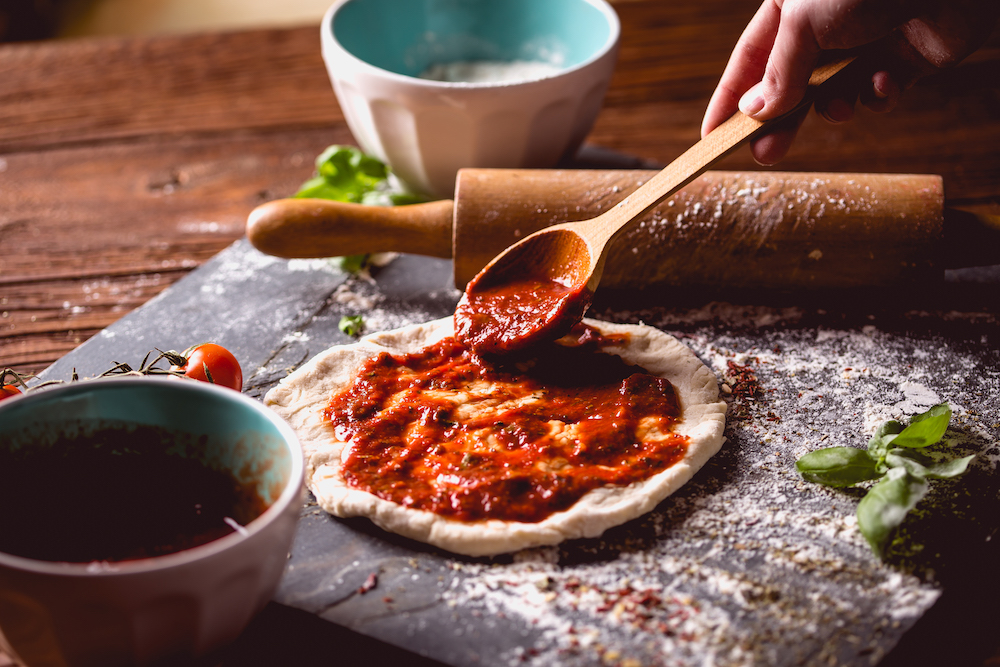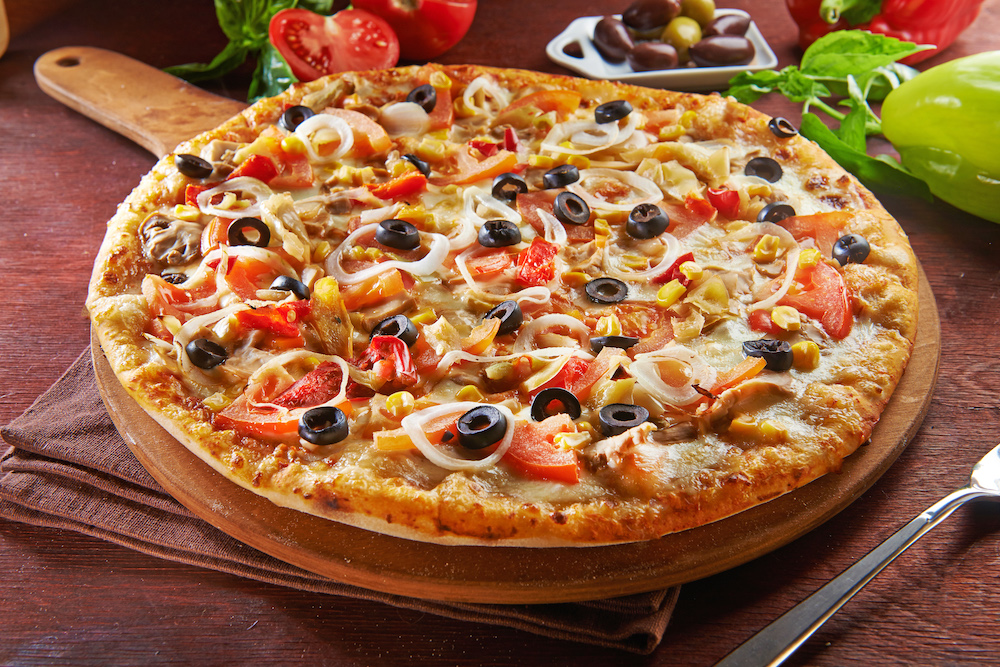Most of us want to eat healthier, and we know we can do that by reducing our fat and sugar intake and increasing our consumption of cereal grains, fresh vegetables, fish and poultry. And that brings us to America’s favorite food: pizza. While some people perceive pizza as low in nutritional value, published data indicate that the opposite is usually true. Most pizzas are actually quite high in nutritional value. They offer a good source of protein, complex carbohydrates, vitamins and minerals, and they are fairly low in caloric density. In short, pizza is good for you as long as you eat it in moderation (just like with anything else).
The protein content of pizza often appears to range from about 10% to just a little more than 14%. Due to the fact that the majority of this protein comes from the cheese and meat toppings, this protein is of a high nutritional quality, which is important to growing children.
When we first look at a pizza, it might appear to be high in fat content. Again, research has shown that the fat content of most pizza rarely exceeds the 10% level. Compare this to a juicy steak with upwards of 20% fat, and you begin to realize just how good pizza really is for you. On top of all this, because vegetable oil, olive oil and oil-based shortenings are commonly used in the crust formulation, pizza and pizza products (calzones, strombolis and bread sticks) are good sources of polyunsaturated fat, with only modest cholesterol contributions (through meat and cheese toppings) to the diet.
Pizzas are also quite high in complex carbohydrates, primarily from starches, making it a good energy food. On the other hand, pizzas tend to be low in fiber content. This is especially true when a regular white pizza flour is used in making the crust. However, when a whole wheat or multi-grain flour is used, the fiber content of the pizza can be improved significantly.
Related: 3 recipes for delicious and healthy pizzas

Getty Images
And we haven’t even mentioned the positive health benefits of lycopene, an antioxidant found in tomatoes and tomato sauce. Lycopene can help lower your blood pressure and your cholesterol, and it’s most effective in the form of cooked tomatoes. Additionally, studies have found a connection between lycopene intake and cancer prevention, particularly for bone, lung and prostate cancers.
OK, but what about caloric content? Research indicates that the caloric content of pizzas does not have to be excessive. In fact, some cheese pizzas have a caloric content not much higher than regular bread products. This translates to about 340 calories for 1/4 of a 13″ cheese pizza, 370 calories for the same portion of a pepperoni pizza, and about 400 calories for 1/4 of a 13″ supreme-topped pizza. Mind you, this applies only to pizzas with a normal application of cheese, not to pizzas with double cheese or with cheese-stuffed crusts in addition to the cheese on the pizza. It should also be recognized that the addition of an extra large portion of meat topping would also significantly increase the caloric content of a pizza. Again, everything is about moderation.
The only issue that still needs to be addressed with pizza is its relatively high sodium content. With meat and cheese toppings being the main contributors of sodium to pizza, the sodium level can be controlled to some extent through judicious use of these toppings and through crust formulations utilizing between 1.25% and 1.5% salt (flour basis).
Aside from the sodium issue, pizza is both a delicious and nutritious food. Two slices (1/4) of a typical, 13″ cheese and meat pizza have been shown to provide almost 1/3 of the daily recommended allowance for protein, 12% to 15% for vitamin A, 30% to 45% for thiamin, 25% to 30% for riboflavin, 20% to 30% for niacin, 40% to 50% for calcium, and 18% to 25% for iron. Overall, this is not a bad contribution to one’s daily diet. And remember, up to this point, we haven’t made any real attempt to change the pizza into a “more nutritional” food, except possibly to limit the amount and type of regular toppings.
Related: Pizza is good for you, no matter what the media says

Making Pizza Even Better for You
So, if you really want to pull out all the stops and produce a pizza with an even better nutritional profile, what can you do? First, look for ways to reduce the sodium content of the pizza. This can be accomplished by formulating the dough with not more than 1.5% salt based upon the weight of the flour, and then looking for topping ingredients that are lower in sodium content: fresh vegetables or other toppings with no added salt. Just about any vegetable can be added as a pizza topping, from classics like onions and peppers to arugula, artichokes, broccoli, zucchini, eggplant and spinach. Each one delivers healthful benefits as well as flavor. Fresh mushrooms, although not classified as vegetables, are also a healthy addition to any pizza; loaded with vitamin D, they can boost the immune system, lower blood pressure and even prevent plaque build-up in blood vessels.
When it comes to cheese, which is a contributor of both sodium and cholesterol, there are engineered cheese products made with cholesterol-free vegetable oil and reduced sodium content. And plant-based vegan cheeses have come a long way in recent years.
Finally, poultry and seafoods are regarded by many as healthier topping choices compared to, say, pork and beef. And chicken-topped pies continue to be very popular with customers around the country.
The next time you are at a major pizza industry trade show, just take a look at the ingredient vendors, and you’ll find any number of toppings being promoted as healthy choices. With all of its nutritional value, great flavor, convenience and variety, it’s no wonder that pizza is the world’s most popular food.
The late Tom “The Dough Doctor” Lehmann was a longtime columnist for PMQ and served as the director of bakery assistance for the American Institute of Baking. This article has been edited and revised from the original version appearing in the September 2001 issue of PMQ.















